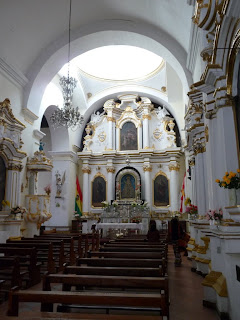

My Piece of Bolivia's History
I first came to Bolivia in 1964, when I was 22. As a Peace Corps Volunteer, I taught at the state university in Cochabamba (La Universidad Mayor de San Simón.) Twelve years before, Bolivia experienced the first major social and economic revolution after that of Mexico in 1910. The MNR (National Revolutionary Movement) initiated land reform, the nationalization of the mines, health reform, public education and unversal suffrage. Bolivia's revolution was supported by Washington. It preceded Cuba's revolution by seven years, a revolution definitely not supported by Washington.
This comes to mind after a conversation, last week, with a recent graduate of the local School of Architecture. He is working, part-time, for my best friend here, Arq. Darío Canseco. Mario (his name) is from a village near Zudañez, a small city about 50 miles from Sucre. His father works the land and plants potatoes, wheat and corn. I can't vouch for this, but it very likely the land was once part of a hacienda and was distributed to the peones who worked for the hacendado five days a week to be able to work a small plot of the master's land the other days. Clearly, Marios' family made major sacrifices to enable him to receive a university education. While in architecture school, he worked as a waiter in one of Sucre's tourist restaurants.
What I am trying to say is that the education and land reform MNR revolution has had a major impact on the lives of Bolivians. Evo Morales' presidency is a direct result of the 1952 revolution and the increasing participation of indigenous groups in national politics. On my way back from the Archives, I passed through a group of "originarios" (the latest term for indigenous peoples) from the community of Qhara Qhara. For the past two weeks, the members of the local allyu (traditional tribal group) have been protesting over their political leadership. At present, they are represented by a "sindicato de campesinos" (peasant union.) I haven't figured out whether this has to do with the strength or values of individual leaders or the authenticity of the governing structure. What I do know is that the "sindicatos de campesinos" was the mechanism used by the MNR in the 1950s to organize the new land-holding ex-hacienda peones. The syndicatos were used by the government to channel campesino votes in their favor. Evo Morales is similarly marshalling "originario" votes emphasizing traditional political organizations with the same objective - maintaining political power. In a complex society with conflicting interests and needs, in the end, is the concentration of power productive?











